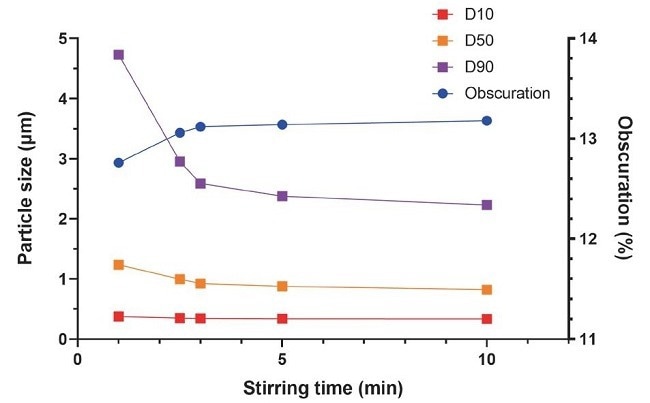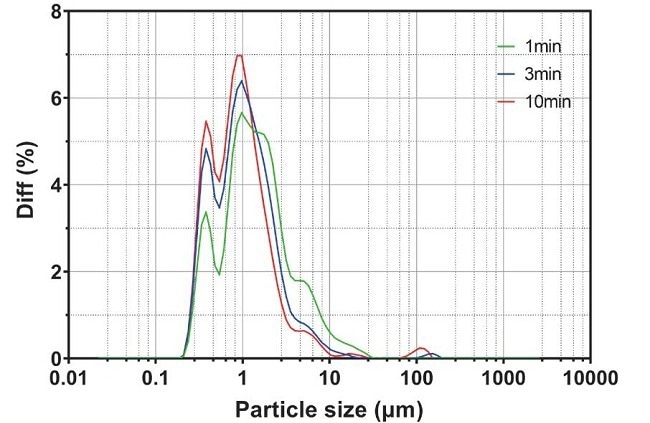Accurately measuring the particle size distribution (PSD) of lithium iron phosphate (LFP) is critical in the optimization of battery performance. The below study examines the difficulties associated with LFP PSD measuring and suggests a specific solution through pre-dispersion with ultrasonication.
The ideal pre-dispersion settings, established using a number of tests, involve ultrasonication at 510 W for 1 minute. This method yields a stable PSD with a D100 value of 10.27 μm and shows excellent repeatability in compliance with ISO 13320 standards.
This method enables researchers and engineers to enhance LFP battery performance and speed up the development of sustainable energy solutions.

Image Credit: Bettersize Instruments Ltd.
Introduction
The emerging electric vehicle (EV) revolution is hinged on the creation of high-performance, sustainable energy solutions. There are, however a variety of limitations that remain a significant challenge.
Lithium-ion batteries are able to offer a good potential avenue, but lithium iron phosphate (LFP) batteries, admired for their exceptional safety and economic viability, pose a trade-off: less gravimetric energy density in comparison to their counterparts, like lithium nickel manganese cobalt oxide (NMC) or lithium nickel cobalt aluminum oxides (NCA). This means diminished driving ranges and prolonged charging times, which impedes larger-scale adoption of LFP batteries on EVs.
There is good news, however, as there is a potential way to tailor the particle size of LFP battery materials. The size of LFP particles within the battery has a profound impact on battery performance. Exploring the operational mechanism of LFP batteries reveals that particle size plays a crucial role in the following aspects:
- Smaller LFP cathode particles have a larger surface area in comparison to their volume. The greater surface area enables more lithium ions to be involved in the reaction with the cathode particles. This means more lithium ions can be stored and released, which makes the battery capable of holding greater amounts of energy without adding to the size of the battery.
- Smaller LFP particles form a more fine porous structure among them, allowing the electrolytes to more easily penetrate into the cathode structure, facilitating better ionic transport, and enabling the battery to charge and discharge quickly.
In simple terms, using a smaller-sized LFP cathode material allows scientists and engineers to improve the energy storage capacity, speed up the charging process, and increase the driving range of EVs. Importantly, this is achieved without compromising the inherent safety and affordability that make LFP batteries a preferred choice in the EV sector.
However, things are not as simple as "the thinner particle size, the better battery performance".
Smaller LFP particles are more likely to degrade mechanically throughout cycling (charging and discharging), which reduces the battery's lifespan. Also, although smaller particles create a porous structure that enables electrolytes to penetrate more effectively, the increased void space between the LFP particles can decrease the overall energy density of the battery.
Therefore, identifying the optimal particle size is crucial for striking a balance between the benefits of a high surface area and the need for a long lifespan, alongside maximizing energy density. This optimization is dependent on the current state of the cathode material and the specific use case of the battery.
To address the performance challenges associated with uniform-sized LFP particles, an optimal approach may lie in employing a mixed particle size distribution (PSD). By strategically combining particles of varying sizes, a balance between the advantages offered by each individual size fraction can be easily achieved.
Smaller particles guarantee enough surface area for lithium-ion interaction, while larger ones assist in maximizing the packing density and structural stability. Therefore, for enhanced battery performance, the accurate measurement and analysis of the PSDs of LFP materials are becoming increasingly crucial for providers of LFP lithium batteries, whether it is single-sized LFP components or complex distributed mixtures.
Measurement Design
Achieving optimal PSD control comes with its own set of challenges. Compared to more conventional methods like sieving, Laser Diffraction Particle Size Analyzers offer a powerful and precise solution to accurately characterize the intricate particle size distribution within LFP electrode materials. This advanced method employs light diffraction principles to assess particle sizes across an extensive range, providing researchers with highly accurate and reproducible data.
To satisfy the need for high-performance LFP lithium batteries, Bettersize Instruments provides the Bettersizer 2600 for precise PSD measurements in the industry.
This instrument is able to optimize the laser diffraction method, resulting in accurate measurement of particle sizes in the range of 0.02 - 2600 μm. Its unique optical design enables versatility for a variety of sample states, from dry powder to wet slurry, with efficient switching between feeding units and dispersion.
In the study outlined in this article, synthesized micron-size LFP particles are sampled as dry powders. The LFP samples are then dispersed in water because of their insolubility. To enhance the reliability of the data, a BT-802 large-volume automatic dispersion unit was utilized alongside the Bettersizer 2600 main unit for PSD measurement. Given the high density of LFP particles relative to water, the stirring speed was adjusted to 1800 rpm to prevent sedimentation.

Bettersizer 2600 with BT-802. Image Credit: Bettersize Instruments Ltd.
Maintaining Measurement Integrity: Addressing Abnormal PSD and Obscuration Trends
To guarantee the reliability of PSD results, a number of tests were completed with the same LFP sample and the same sampling method but with unique stirring/circulation times. In relation to the extended stirring time and circulating the sample suspension, the PSD result showed a trend of decreasing while the obscuration value was increasing, as shown in Figure 1.

Figure 1. Abnormal PSD and Obscuration Trends. Image Credit: Bettersize Instruments Ltd.
A clear pattern emerges in most cases: extended stirring results in a stable PSD and a consistent obscuration value. Yet, the behavior of LFP samples was unexpectedly different: the PSD reduced with prolonged stirring, and the obscuration value rose. Additionally, the trend observed in LFP samples hints at a more intricate process, with the PSD "differentiation" suggesting a dual mechanism at play, as depicted in Figure 2.

Figure 2. The PSD "differentiation" phenomenon. Image Credit: Bettersize Instruments Ltd.
What seems to be a paradoxical phenomenon leads to an unstable state within the sample suspension, also called unsaturated dispersion, highlighting the limitations of conventional stirring dispersion approaches for LFP samples.
The shearing forces created by the stirring mechanism are not enough to overcome the inherent cohesive forces keeping the LFP particles together, which leads to incomplete dispersion and the observed "differentiation" process.
Overcoming Unsaturated Dispersion with Tailored Pre-Treatment
To address the issue of insufficient dispersion, an increase in dispersion energy is required to disperse agglomerated particles quickly. The dual-stage dispersion, which includes a pre-dispersion stage and the dispersion stage while measuring, is applicable here. In this situation, a thicker suspension was prepared by combining LFP dry powders with deionized water, and the pre-disperse stage was completed with the thicker suspension.
Harnessing Ultrasonic Energy for Effective Dispersion
To surpass the limitations of conventional stirring methods, ultrasonication has become an effective pre-dispersion step. This method uses high-frequency sound waves to create intense shear forces, effectively breaking apart agglomerated LFP particles and promoting a more uniform suspension.
The prepared thicker suspension was ultrasonicated and subsequently diluted with the BT-802 before actual PSD measurements. Each test was done directly following the addition of samples in BT-802 to create a stable suspension.
Finding the Optimal Pre-Dispersion Strategy
This investigation involved a number of tests exploring different ultrasonication power and duration combinations. As illustrated in Table 1, the findings underscore the importance of adequate dispersion energy for attaining a stable PSD. This energy can be delivered through either increased ultrasonication power or increased treatment time.
Table 1. PSD typical value of different ultrasonication power and duration combinations. Source: Bettersize Instruments Ltd.
| Power (W) |
Typical Value (μm) |
30 seconds |
1 minute |
3 minutes |
5 minutes |
| 270W |
D10 |
0.328 |
0.327 |
0.324 |
0.325 |
| D50 |
0.817 |
0.773 |
0.758 |
0.762 |
| D90 |
4.740 |
2.426 |
2.323 |
2.242 |
| 360W |
D10 |
0.330 |
0.327 |
0.326 |
0.324 |
| D50 |
0.813 |
0.757 |
0.746 |
0.752 |
| D90 |
3.039 |
2.970 |
2.354 |
2.344 |
| 420W |
D10 |
0.324 |
0.324 |
0.324 |
0.324 |
| D50 |
0.731 |
0.728 |
0.729 |
0.724 |
| D90 |
1.830 |
1.790 |
1.755 |
1.753 |
| 510W |
D10 |
0.325 |
0.326 |
0.324 |
0.324 |
| D50 |
0.724 |
0.722 |
0.721 |
0.719 |
| D90 |
1.726 |
1.706 |
1.703 |
1.705 |
| 570W |
D10 |
0.325 |
0.325 |
0.325 |
0.325 |
| D50 |
0.719 |
0.715 |
0.718 |
0.719 |
| D90 |
1.693 |
1.707 |
1.708 |
1.704 |
Striking a Balance: 510W and 1 Minute for Optimal Results
Finding a balance between power and efficiency, 510 W for 1 minute can be readily identified as the ideal pre-dispersion setting for the LFP sample being investigated. This configuration effectively disperses the particles, resulting in a stable PSD with a D100 value of 10.27 μm.
Validation Through Repeatability Testing
To guarantee the reliability of this pre-dispersion method, six repeated measurements were taken. Figure 3 presents the results and demonstrates excellent repeatability. The standard deviations for D10, D50, and D90 values were impressively low (0.12 %, 0.05 %, and 0.09 %, respectively), showing full compliance with ISO 13320 requirements.

Figure 3. Repeatability test of PSD measurement procedure. Image Credit: Bettersize Instruments Ltd.
Conclusion
Precise control of LFP particle size distribution plays a pivotal role in battery performance. Laser diffraction analysis, showcased by the Bettersizer 2600, provides a valuable tool when monitoring PSD in the lithium battery industry.
When it comes to LFP materials with unique dispersion issues, implementing an optimized pre-dispersion procedure, like the ultrasonication method previously described, proves critical. This study highlights the effectiveness of this method, demonstrating its ability to achieve reliable, stable, and repeatable PSD measurements, which ultimately empowers researchers and engineers to optimize LFP battery performance.

This information has been sourced, reviewed and adapted from materials provided by Bettersize Instruments Ltd.
For more information on this source, please visit Bettersize Instruments Ltd.
